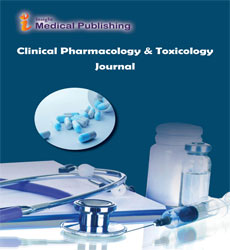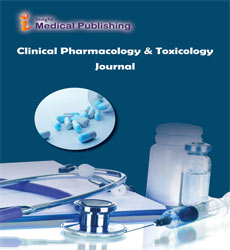Therapeutic Drug Monitoring: Optimizing Efficacy and Safety
*Corresponding author:
Gorius Jaggli,
Department of Biomedical Sciences, University of Cagliari, 09042 Cagliari, Italy,
E-mail: Jaggli.goriu@unica.it
Received date: February 01, 2025, Manuscript No. iprrt-25-20704; Editor assigned date: February 03, 2025, PreQC No. iprrt-25-20704 (PQ); Reviewed date: February 15, 2025, QC No. iprrt-25-20704; Revised date: February 22, 2025, Manuscript No. iprrt-25-20704 (R); Published date: February 28, 2025
Citation: Jaggli G (2025) Therapeutic Drug Monitoring: Optimizing Efficacy and Safety. Clin Phar Toxi Jour Vol.09 No.1:03
Introduction
Therapeutic Drug Monitoring (TDM) is a clinical practice aimed at optimizing drug therapy by measuring drug concentrations in biological fluids, primarily blood, to ensure efficacy while minimizing toxicity. It is especially relevant for drugs with narrow therapeutic windows, significant inter-individual variability in pharmacokinetics, or complex metabolism. TDM bridges the gap between pharmacology and clinical practice, allowing individualized dosing and informed therapeutic decisions. By integrating drug concentration data with patient-specific factors such as age, weight, organ function, comorbidities, and concurrent medications, TDM enhances treatment outcomes and reduces the risk of adverse effects. Advances in analytical techniques, pharmacokinetic modeling, and precision medicine have expanded the utility of TDM across diverse therapeutic areas, including oncology, psychiatry, infectious diseases, and immunosuppressive therapy [1].
Description
The rationale for TDM stems from the variability in drug absorption, distribution, metabolism, and excretion among individuals. Factors such as genetic polymorphisms in drug-metabolizing enzymes, interactions with other medications, organ dysfunction, and adherence influence plasma drug levels and therapeutic response. Drugs with a narrow therapeutic index, such as anticonvulsants, immunosuppressants, certain antibiotics, and chemotherapeutic agents, are particularly susceptible to suboptimal dosing. Insufficient drug levels may lead to therapeutic failure, whereas excessive concentrations increase the risk of toxicity.
TDM provides a quantitative framework to guide dose adjustments based on measured concentrations, improving both efficacy and safety. Analytical techniques for TDM have evolved significantly, ranging from traditional immunoassays to High-Performance Liquid Chromatography (HPLC), liquid chromatographyâ??tandem mass spectrometry (LC-MS/MS), and biosensor-based approaches. LC-MS/MS, in particular, offers high sensitivity, specificity, and multiplexing capabilities, allowing simultaneous measurement of multiple drugs and metabolites. Advances in point-of-care testing and microfluidics are also enabling rapid, bedside monitoring, facilitating real-time therapeutic decisions in clinical settings [2]. TDM is applied in various therapeutic domains. In oncology, drugs such as methotrexate, 5-fluorouracil, and tyrosine kinase inhibitors demonstrate significant inter-patient pharmacokinetic variability. Monitoring plasma concentrations enables clinicians to adjust doses, minimize adverse effects like myelosuppression or hepatotoxicity, and optimize antitumor efficacy. Similarly, immunosuppressants used in transplantation, such as tacrolimus, cyclosporine, and sirolimus, exhibit narrow therapeutic windows and considerable variability in metabolism due to CYP3A5 polymorphisms. TDM ensures adequate immunosuppression to prevent graft rejection while avoiding nephrotoxicity, hypertension, and infection [1].
In psychiatry, TDM is applied to psychotropic drugs including lithium, valproate, and tricyclic antidepressants. Monitoring plasma concentrations allows personalized dosing, improves adherence assessment, and reduces risks of toxicity, such as neurotoxicity with lithium or cardiotoxicity with tricyclics. TDM also aids in detecting drug interactions, particularly in polypharmacy scenarios, which are common in psychiatric care. In infectious diseases, TDM optimizes antimicrobial therapy, particularly for aminoglycosides, vancomycin, and antifungal agents. For aminoglycosides, monitoring peak and trough concentrations prevents nephrotoxicity and ototoxicity while maintaining bactericidal activity. Vancomycin dosing guided by TDM reduces the risk of nephrotoxicity and ensures therapeutic levels for severe infections such as MRSA bacteremia. Antifungal therapy with agents like voriconazole benefits from TDM due to nonlinear pharmacokinetics, genetic polymorphisms in CYP2C19, and significant inter-patient variability. These examples illustrate how TDM supports precision dosing, improving both safety and clinical outcomes [2].
Pharmacokinetic and pharmacodynamic modeling complements TDM by predicting drug behavior in individual patients. Population pharmacokinetics and Bayesian forecasting integrate measured drug concentrations, patient-specific variables, and dosing history to optimize dosing regimens. This approach is particularly valuable in critically ill patients, neonates, and patients with renal or hepatic impairment, where standard dosing may be inadequate. Integrating TDM with pharmacometric modeling facilitates individualized therapy, guiding clinicians in complex clinical scenarios. The benefits of TDM extend beyond dose adjustment. TDM helps identify non-adherence, drug interactions, and changes in drug metabolism over time. It can inform decisions on switching medications or modifying therapy in response to physiological changes, such as pregnancy or organ dysfunction.
Additionally, TDM contributes to pharmacovigilance by detecting early signs of toxicity or sub therapeutic exposure, supporting safer long-term treatment strategies.
Conclusion
Therapeutic Drug Monitoring is a cornerstone of personalized medicine, optimizing drug therapy by balancing efficacy and safety. By measuring drug concentrations, integrating patient-specific factors, and applying pharmacokinetic and pharmacodynamic principles, TDM enables precise dosing, improves therapeutic outcomes, and minimizes adverse effects. Its applications span oncology, transplantation, psychiatry, infectious diseases, and critical care, highlighting its versatility and clinical relevance. Technological advancements in analytical methods, modeling, and point-of-care devices are expanding the scope and efficiency of TDM, supporting real-time decision-making and individualized therapy. Despite challenges in implementation and interpretation, TDM remains a vital tool for precision medicine, ensuring that patients receive the right drug, at the right dose, at the right time.
Acknowledgement
None.
Conflict of Interest
None.
References
- Bonga, S.W., Löwik, C.J.M and Van der Meij, J.C.A. (1983) Effects of external Mg2+ and Ca2+ on branchial osmotic water permeabiligy and prolactin secretion in the teleost fish Sarotherodon mossambicus. Gen Comp Endocrinol 52: 222-231.
Google Scholar Cross Ref Indexed at
- Harrow, J.A., Das, P.K and Dhalla, N.S (1978). Influence of some divalent cations on heart sarcolemmal bound enzymes and calcium binding. Biochem Pharmacol 27: 2605-2609.

Open Access Journals
- Aquaculture & Veterinary Science
- Chemistry & Chemical Sciences
- Clinical Sciences
- Engineering
- General Science
- Genetics & Molecular Biology
- Health Care & Nursing
- Immunology & Microbiology
- Materials Science
- Mathematics & Physics
- Medical Sciences
- Neurology & Psychiatry
- Oncology & Cancer Science
- Pharmaceutical Sciences
